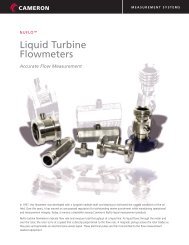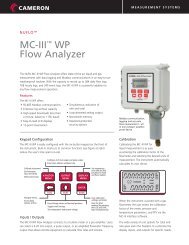Download Diode Protection For Redundant ... - Proflow Systems
Download Diode Protection For Redundant ... - Proflow Systems
Download Diode Protection For Redundant ... - Proflow Systems
Create successful ePaper yourself
Turn your PDF publications into a flip-book with our unique Google optimized e-Paper software.
<strong>Diode</strong> <strong>Protection</strong> <strong>For</strong> <strong>Redundant</strong> Power Supplies<br />
A DC power supply is a critical piece of a control system. Power supply<br />
failure can lead to a process shutting down resulting in considerable lost<br />
revenue. To prevent unplanned shutdowns users often use redundant power<br />
supplies, i.e. power supplies with their outputs connected in parallel, where if one<br />
supply fails there are enough remaining power supplies to deliver the required<br />
load current.<br />
<strong>Redundant</strong> power supplies can be also be used for increased current<br />
capacity – in this case the concern is less about unplanned shutdowns but rather<br />
the fact one supply cannot deliver the load current required. <strong>For</strong> increased<br />
current capacity power supplies with “active load sharing” are preferred. This<br />
involves the power supplies communicating with each other and adjusting their<br />
output voltages so that each supply delivers the same current. If two supplies<br />
are used each one will deliver half the required current. If three supplies are<br />
used each one delivers a third of the total current required. Without active load<br />
sharing each power supply must be adjusted so that their output voltages are<br />
identical, they much be maintained at the same ambient temperature and the<br />
wiring between each power supply and the common point should be of equal<br />
lengths – all difficult conditions to maintain.<br />
Figure 1 – <strong>Redundant</strong> Power Supplies with “ORing” <strong>Diode</strong>s<br />
Regardless of the reason for using redundant power supplies it is common<br />
practice to connect a diode in series with the output of each power supply so a<br />
failed power supply cannot draw current from any operating power supplies. If<br />
there is a short circuit in the output of a power supply that unit will shutdown but it<br />
could also short circuit any power supplies connected in parallel causing those to
shutdown as well. A diode on the output of each supply prevents this from<br />
happening.<br />
Figure 2 – <strong>Diode</strong> prevents P/S 1 from shutting off if P/S 2 short circuits<br />
Using diodes to isolate power supplies, often referred to as “ORing<br />
diodes”, has the disadvantage of increasing power dissipation within the control<br />
cabinet. A typical diode drops the voltage 0.7V when conducting a current. This<br />
means 0.7W per amp of load current. If two redundant power supplies are<br />
delivering a total of 10A then the diodes will dissipate 7W in the cabinet. Using<br />
Schottky diodes could lower the power dissipation to approximately 4W. Either<br />
way, this power dissipation is unwanted and increases the ambient temperature<br />
within the cabinet. Sometimes bridge rectifiers are used because they are<br />
relatively inexpensive, are designed for high power dissipation, and can be<br />
mounted directly on the wall of the cabinet so that the cabinet acts as a heat sink.<br />
Reliability is a concern (or should be) when using ORing diodes. If a<br />
diode fails in a short circuited state then there is no protection and the voltage<br />
from that supply appears to increase by 0.7V. Unless active load sharing is used<br />
that supply may try to deliver the total load current. If the power supplies are<br />
connected in parallel for increased current capacity then the supply might go in to<br />
an overcurrent condition and shutdown. If one of the ORing diodes fails in an<br />
open circuit state then there is no longer any redundancy and a shutdown of thr<br />
remaining power supply could occur.
<strong>Diode</strong><br />
No additional circuitry required<br />
Low cost<br />
High power dissipation<br />
Large packaging due to heat sink<br />
MOSFET<br />
Control circuitry required<br />
Higher cost<br />
Very low power dissipation<br />
Compact packaging<br />
Although the circuitry used in an active diode circuit is more expensive<br />
than a diode alone this is partially offset by the fact there is no need for a heat<br />
sink (or only a small heat sink is required). Active diode circuits can be very<br />
compact and easily packaged in DIN rail mounted housings.<br />
The photo above shows two ORing modules with the same rating – two<br />
20A inputs and a 40A output. The one on the right uses diodes and requires just<br />
over 110mm of DIN rail and includes a cooling fan to allow it to operate at high<br />
ambient temperatures. The unit on the left is an active diode module and
equires just 38mm of DIN rail. It can operate at the same elevated ambient<br />
temperature but requires no cooling fan.<br />
Shown above is an active diode module to be released by Emphatec in<br />
early 2013. It is rated 15A and requires just 8mm of DIN rail. This unit features a<br />
single input and output – it does not perform an ORing function on its own. One<br />
of these modules would be installed per power supply.
















